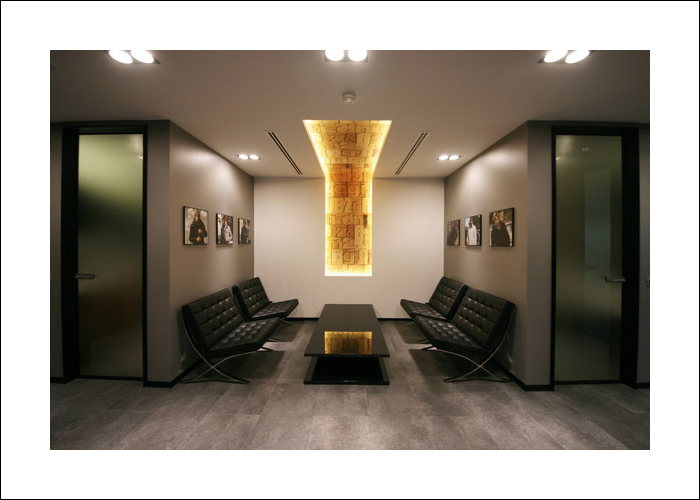Although another element of design, colour, is applied, proportion is also a key contributor in making this lounge space at Creston (designed by The Interiors Group) really stand out.
For our final post in our blog series, we are going to focus on the elements of design, scale and proportion. In commercial Interior Design, the most important objective for a project is to enhance our everyday experiences within the environments we work, live, and play. Although consideration of all the elements of design is necessary to achieve this goal, scale and in turn, proportion have the largest impact on spatial functionality.

The classic Barcelona chair is an icon, but because it’s so low it often appears as though it is not sized appropriately for our modern human scale. In the room pictured above by Design Partners International for Kuper, vertical line has been applied to the ceiling and wall to draw the eye down and add a sense of proportion to the space. Without this consideration for scale and proportion, this room may not be so well balanced simply due to the low horizontal nature of the seating.
Scale
Without consideration of scale, in particular, human scale, our everyday activities would be more difficult. Scale refers to the relationship between two or more objects, one that has a commonly known size. In most cases, the size of objects is compared to our own human scale.
We can find examples of this in our homes and workplaces; for instance, standardized heights have been created for countertops, chairs have been scaled to fit our bodies, the widths of hallways allow for people to comfortably pass one another. You can see that the way we build our environment is based on the commonly known anthropometric data of human scale.

The application of contrasting colour and texture on the ceiling, walls, and floor, as well as the incorporation of low horizontal furniture could lead to this room feeling out of scale; however, DAP Studio masterfully counterbalanced this effect by repeating and lowing the horizontal light fixtures.
Proportion
Proportion is a word often used interchangeably with scale although there is one subtle difference between the two definitions. While the word scale implies the comparison of objects where the actual size of one object is known, proportion relates to the general size of two objects without information regarding their actual sizes (or scales).
While scale is more absolute, proportion is truly relative and requires the interior designer to understand the interactions between objects within a 3 dimensional space. For most designers, it’s a difficult thing to explain when objects in a room are in proportion – this is what we refer to as having “an eye for design”.
There is no right or wrong when it comes to this application of proportion. As it can alter the way our spaces look and feel, getting proportion “right” all depends on the intent of the designer.

Often interior designers will apply proportion in contrasting ways to emphasize a particular area. This design by LemayMichaud Architecture Design is a great example of this; note how the oversized fixtures really call attention to the bar.
In most cases designers aim to achieve proportion within the spaces they design; however, there are times when the design goals call for disproportion. One way to create emphasis in a space is to introduce oversized items in a way that is disproportionate for the space. For instance, large pendant lights over a cash counter or boardroom table could call attention to that area.
Although understanding the ideas behind proportion and scale are important, design requires an awareness of every element and principal (check back for future blog posts about the various principals of design). It must be said that Interior design is complicated; there are so many interactions between all the elements of design and these interactions, as a whole, have an effect on the feel of a space.
Did you miss our post about line? Read about it by clicking here.
Did you miss our post about colour? Read about it by clicking here.
Did you miss our post about texture and pattern? Read about it by clicking here.
Did you miss our post about light? Read about it by clicking here.
» Do you need help with your commercial Interior Design project? Contact Hatch Interior Design located in Kelowna, British Columbia – Sustainable Interior Solutions for the Modern Workplace.
